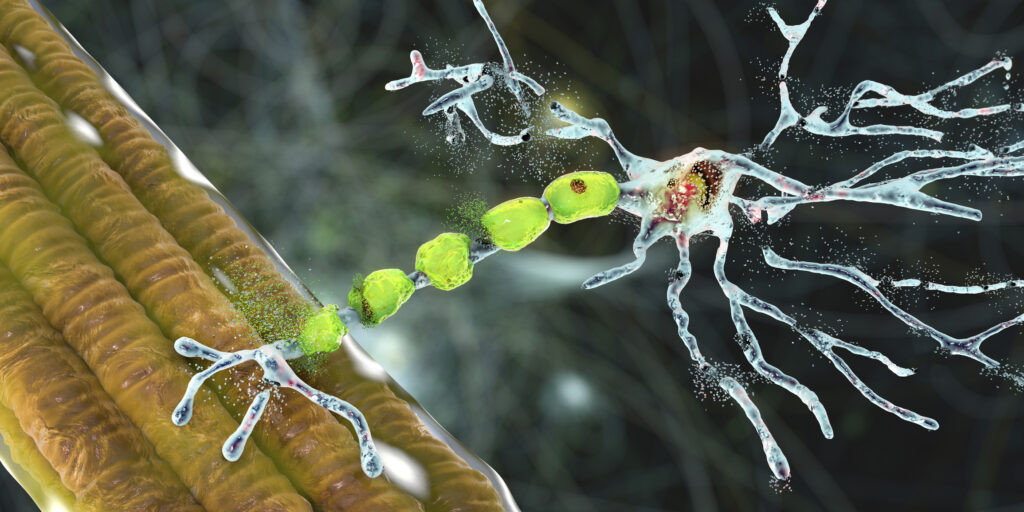
Simply Stated: Updates in Neuromuscular Junction (NMJ) Disorders
By Sujatha Gurunathan | Monday, March 31, 2025
5 Second Summary
“Simply Stated” is a Quest column designed to explain some terms and basic facts about neuromuscular diseases.
Find more at Mdaquest.org/tag/simply-stated
The neuromuscular junction (NMJ) disorders are a group of conditions that disrupt the communication between motor neurons and muscles, resulting in muscle weakness, fatigue, problems with movement and mobility, and, in severe cases, paralysis. Recognized NMJ disorders include the autoimmune disorders myasthenia gravis (MG) and Lambert-Eaton myasthenic syndrome (LEMS), the genetic conditions known as congenital myasthenic syndromes, and the bacterially-derived illness botulism, among others. The NMJ disorders are rare; a form of MG, acetylcholine receptor (AChR) antibody-positive (ab+) MG, is thought to be the most common, with an estimated worldwide incidence of 29 cases per 1 million people per year.
Cause of NMJ disorders
NMJ disorders may be confused with motor neuron diseases, such as amyotrophic lateral sclerosis (ALS), because both are characterized by progressive muscle weakness. The underlying cause of these disease types, however, is what differentiates them. Motor neuron diseases involve the degeneration of motor neurons, while NMJ disorders involve defects at the neuromuscular junction (NMJ).
The NMJ is the place where neurons connect with muscle fibers in the body. When neurons receive specific impulses from the brain, they release a chemical messenger known as acetylcholine (ACh). This messenger travels across the NMJ and is sensed by acetylcholine receptors (AChRs) on muscles cells. Other receptors at the NMJ (e.g., muscle-specific kinase (MuSK) and low-density lipoprotein receptor-related protein 4 (LRP4)), help with ACh signaling and also with maintaining the structure of the NMJ. The transmission of information from neurons to muscle fibers causes the muscle to contract. Afterwards, the ACh messenger is broken down by an enzyme known as acetylcholinesterase (AChE). This terminates the signal so that the ACh does not continue to stimulate muscle contraction indefinitely.
NMJ disorders occur when the communication between neurons and muscle fibers is disrupted. This can occur due to a variety of factors including autoimmune conditions, genetic mutations, and exposure to toxins.
Types of NMJ disorders
Many different defects can disrupt signaling at the NMJ and cause NMJ disorders. These disorders can present with a variety of symptoms, including muscle weakness, fatigue, difficulty swallowing, respiratory problems, eye muscle weakness, and muscle cramps, among others. Some NMJ disorders are mild and manageable with treatment, while others can be life-threatening. The disorders include:
Autoimmune disorders
Myasthenia gravis (MG) is caused by autoantibodies against AChR or associated proteins (MuSK, LRP4). People with MG experience fluctuating weakness that worsens with activity. MG presents in two main forms, ocular MG (oMG) in which weakness is limited to the eyelids and muscles controlling eye movements and generalized MG (gMG) in which weakness may affect the eyelid/eye muscles, but also involves a combination of muscles in the face/neck and limbs, and muscles required for breathing. In some people, MG is linked to a tumor of the thymus gland (thymoma).
Lambert-Eaton myasthenic syndrome (LEMS) is caused by autoantibodies against specific calcium channels found on nerve cells, leading to reduced ACh release. People with LEMS experience muscle weakness close to the body center (proximal muscles) that typically improves with activity. In many people, LEMS is associated with malignancy, most commonly small-cell lung cancer (SCLC).
Congenital myasthenic syndromes (CMS)
Mutations in the AChR or other NMJ proteins can disrupt communication at the NMJ, leading to the genetic disorders known as congenital myasthenic syndromes (CMS). The onset of CMS is typically in infancy or childhood and affected children experience symptoms similar to those with MG, such as weakness that worsens with activity, though the exact symptoms vary depending on the underlying genetic defect.
Learn more about CMS causes and treatments in a Q&A with researcher Hanns Lochmüller, MD, PhD.
Toxic/drug-induced NMJ disorders
Botulism is caused by a toxin produced by the Clostridium botulinum bacteria, which prevents ACh release from neurons at the NMJ. This can lead to paralysis and problems with involuntary body functions like breathing and digestion.
Organophosphate poisoning, resulting from exposure to some chemical agricultural products or weapon reagents, inhibits AChE, causing excessive ACh accumulation at the NMJ. This can lead to muscle weakness, twitching (fasciculations), and respiratory failure.
Some medications, such as muscle relaxants, can also impair communication at the NMJ.
To learn more about the causes, signs and symptoms, and management concerns of NMJ disorders, see the following review articles about MG, CMS, and NMJ-related diseases.
Current management of NMJ disorders
Modern therapies have considerably improved the prognosis for people living with certain NMJ disorders, such as MG. Other NMJ disorders still represent a great unmet need. To date, a handful of therapies have been approved by the US Food and Drug Administration (FDA) to treat NMJ disorders. These include:
Approved MG therapies
Soliris (eculizumab) – Approved in 2017
Vyvgart (efgartigimod) – Approved in 2021
Ultomiris (ravulizumab-cwvz) – Approved in 2022
Rystiggo (rozanolixizumab-noli) – Approved in 2023
Approved LEMS therapies
Firdapse (amifampridine) – Approved in 2018
Treatment decisions for NMJ disorders are based on the specific symptoms and disease course experienced by each person with the disease. The primary therapies used to treat MG are:
Symptomatic treatment:
- Acetylcholinesterase (AChE) inhibitors (e.g., pyridostigmine, neostigmine) – Increase nerve-to-muscle communication
Disease modifying treatments:
- Corticosteroids (e.g., prednisone) – Inhibit the immune system
- Non-steroid Immunosuppressants (e.g., mycophenolate mofetil, azathioprine, cyclosporine, tacrolimus) – Modulate the immune response
- Intravenous immunoglobulin (IVIG) – Introduces normal antibodies into the blood
- Plasma Exchange/Therapeutic Apheresis – Filters out abnormal antibodies from the blood; typically used in severe cases for rapid symptom relief
- Complement Inhibitors (e.g., eculizumab, ravulizumab) – Block an immune pathway that contributes to disease
- Neonatal Fc receptor inhibitor (e.g., efgartigimod, rozanolixizumab-noli,) – Helps to eliminate abnormal antibodies
- Thymectomy – Removes the defective thymus
Treatment of LEMS and CMS has some similarity to treatment of MG. AChE inhibitors, immunosuppressants, and procedures such as plasmapheresis and IVIG infusion may be used for disease management. Inhibitors of other NMJ proteins may also be recommended, depending on the cause of disease. In the case of LEMS associated with SCLC, treatment of the underlying cancer may also be necessary.
The goal of management in NMJ disorders is to decrease symptoms to their lowest point, while minimizing side effects from medications. In most cases, symptoms can be well-controlled with treatment and people with NMJ disorders can experience a high quality of life.
Evolving research and treatment landscape
Research advances and the promise of better therapeutics on the horizon offer the hope of improved disease management for people living with NMJ disorders. A number of therapies are in clinical trials for the NMJ disorders. Some are approved therapies being studied for expanded use, while others represent novel investigational therapies.
These include (not an exhaustive list):
Investigational MG therapies
- B-cell depletion therapies (e.g., rituximab, inebilizumab) – Prevent the formation of abnormal antibodies
- Complement inhibitors (e.g., eculizumab, ravulizumab, zilucoplan, gefurulimab) – Block an immune pathway that contributes to disease
- Interleukin-6 inhibitor (e.g., satralizumab) – Blocks an immune pathway and cells that contribute to disease
- Neonatal Fc receptor inhibitors (e.g., efgartigimod, rozanolixizumab, batoclimab, nipocalimab) – Help to eliminate abnormal antibodies
- Chimeric antigen receptor T cell (CAR-T) therapy (e.g., Descartes-08, KYV-101, MuSK-CAART) – Uses a cell-based approach to stop B-cells from making abnormal antibodies
Investigational CMS therapies
- MuSK activator (e.g., ARGX-119) – Activates MuSK at the NMJ, thereby stabilizing or improving NMJ function
To learn more about clinical trial opportunities in NMJ disorders, visit clinicaltrials.gov and search for the disorder name in the condition or disease field.
MDA’s work to further cutting-edge NMJ research
Since its inception, MDA has invested more than $71 million in the research of NMJ disorders. MDA funding has helped to support foundational research underlying development of targeted therapies for NMJ disorders, including the US Food and Drug Administration (FDA)-approved drugs amifampridine, efgartigimod, ravulizumab-cwvz, rozanolixizumab-noli, and zilucoplan.
MDA’s Resource Center provides support, guidance, and resources for patients and families, including information about neuromuscular junction disorders, open clinical trials, and other services. Contact the MDA Resource Center at 1-833-ASK-MDA1 or ResourceCenter@mdausa.org.
Next Steps and Useful Resources
- To learn more about the causes, signs and symptoms, and management concerns of NMJ disorders, see the following review articles about MG, CMS, and NMJ-related diseases.
- For more information about the Congenital Myasthenic Syndromes (CMS), an in-depth review can be found here.
- For more information about the types and characteristic symptoms of Lambert-Eaton myasthenic syndrome (LEMS), as well overview of diagnostic and management concerns, an in-depth overview can be found here.
- For more information about the types and characteristic symptoms of Myasthenia gravis (MG), as well overview of diagnostic and management concerns, an in-depth overview can be found here.
- To learn more about clinical trial opportunities in NMJ disorders, visit clinicaltrials.gov and search for the disorder name in the condition or disease field.
- MDA’s Resource Center provides support, guidance, and resources for patients and families, including information about glycogen storage diseases, open clinical trials, and other services. Contact the MDA Resource Center at 1-833-ASK-MDA1 or ResourceCenter@mdausa.org.
- Stay up-to-date on Quest content! Subscribe to Quest Magazine and Newsletter.
TAGS: Simply Stated
TYPE: Blog Post
Disclaimer: No content on this site should ever be used as a substitute for direct medical advice from your doctor or other qualified clinician.




